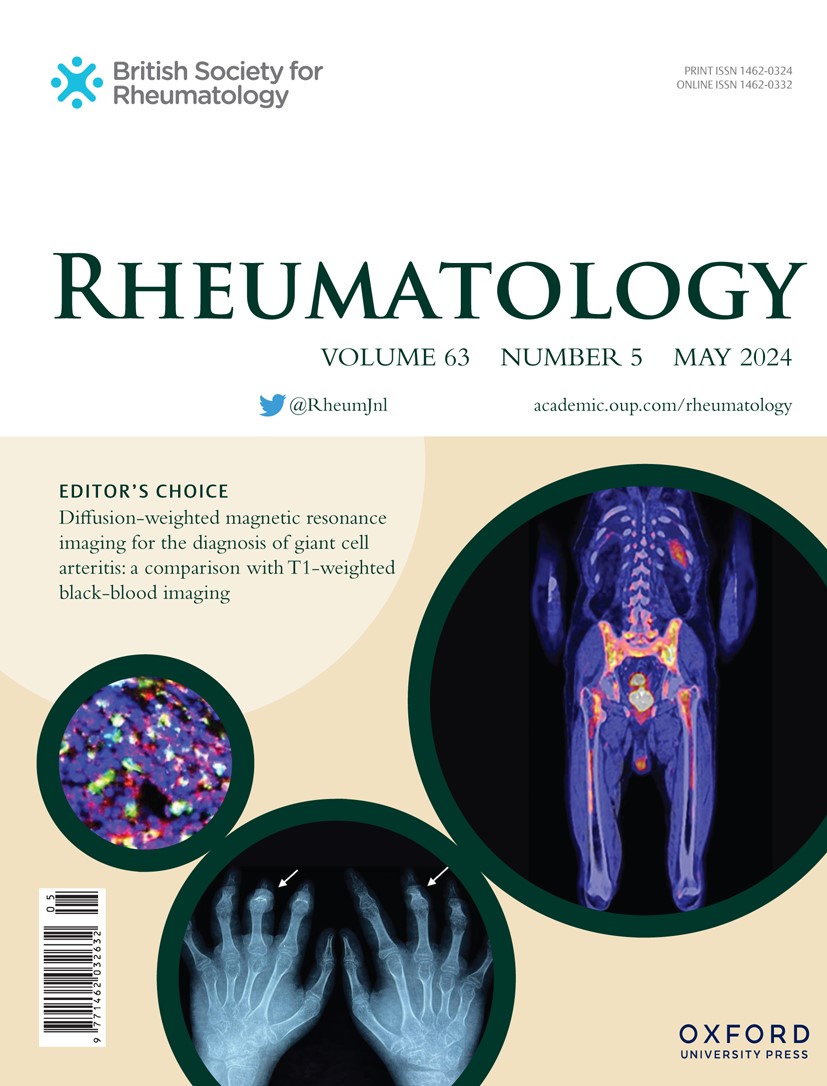Systemic lupus erythematosus-disease activity score remission and low disease activity were similarly associated with patient-reported outcomes compared with definition of remission in systemic lupus erythematosus remission and lupus low disease activity state.
IF 4.7
2区 医学
Q1 RHEUMATOLOGY
引用次数: 0
Abstract
OBJECTIVES The treat-to-target (T2T) approach for systemic lupus erythematosus (SLE) has recently been proposed. However, the most suitable criterion for determining remission or low disease activity (LDA) using patient-reported outcomes (PROs) remains unknown. This study aimed to compare the relationship between PROs and various remission criteria, including the definition of remission in SLE (DORIS), SLE disease activity score (SLE-DAS) remission, lupus low disease activity state (LLDAS), and SLE-DAS LDA. METHODS A multicentre prospective study was conducted involving patients with SLE who visited Juntendo University and its affiliated hospitals between 2018 and 2024. A cross-sectional analysis was performed using surveys completed by physicians and patients. Multivariate analyses were performed to explore the relationship between PROs and remission/LDA criteria. Quality of life was evaluated using the medical outcomes study 36-item short-form health survey (SF-36) and EuroQol-5D. RESULTS This study included 334 patients. All remission and LDA criteria were significantly associated with the SF-36 physical component summary, with SLE-DAS remission demonstrating superior accuracy metrics compared with DORIS remission. No associations were observed with the mental component summary for any remission or LDA criteria. Regarding the EuroQol-5D, no correlations were identified with DORIS remission; however, correlations were observed with other remissions and LDA criteria. CONCLUSION Remission and LDA criteria based on the safety of estrogens in lupus erythematosus national assessment SLE disease activity index and SLE-DAS exhibited similar associations with PROs. SLE-DAS remission and LDA represent valid treatment targets in a T2T approach, comparable to DORIS remission and LLDAS in terms of PROs.与系统性红斑狼疮缓解和狼疮低疾病活动度的缓解定义相比,系统性红斑狼疮疾病活动度评分缓解和低疾病活动度与患者报告的结果相似。
目的:系统性红斑狼疮(SLE)的T2T治疗方法最近被提出。然而,使用患者报告的结果(PROs)来确定缓解或低疾病活动性(LDA)的最合适标准仍然未知。本研究旨在比较PROs与各种缓解标准之间的关系,包括SLE缓解的定义(DORIS)、SLE疾病活动性评分(SLE- das)缓解、狼疮低疾病活动性状态(LLDAS)和SLE- das LDA。方法采用多中心前瞻性研究,纳入2018年至2024年在顺天大学及其附属医院就诊的SLE患者。通过医生和患者完成的调查进行了横断面分析。进行多变量分析以探讨PROs与缓解/LDA标准之间的关系。使用医疗结果研究36项短期健康调查(SF-36)和EuroQol-5D评估生活质量。结果本研究纳入334例患者。所有缓解和LDA标准都与SF-36物理成分总结显著相关,与DORIS缓解相比,slel - das缓解显示出更高的准确性指标。没有观察到与任何缓解或LDA标准的精神成分总结相关。关于EuroQol-5D,未发现与DORIS缓解相关;然而,观察到与其他缓解和LDA标准的相关性。结论基于雌激素安全性的红斑狼疮缓解和LDA标准与pro具有相似的相关性。在T2T方法中,SLE-DAS缓解和LDA是有效的治疗目标,在PROs方面与DORIS缓解和LLDAS相当。
本文章由计算机程序翻译,如有差异,请以英文原文为准。
求助全文
约1分钟内获得全文
求助全文
来源期刊

Rheumatology
医学-风湿病学
CiteScore
9.40
自引率
7.30%
发文量
1091
审稿时长
2 months
期刊介绍:
Rheumatology strives to support research and discovery by publishing the highest quality original scientific papers with a focus on basic, clinical and translational research. The journal’s subject areas cover a wide range of paediatric and adult rheumatological conditions from an international perspective. It is an official journal of the British Society for Rheumatology, published by Oxford University Press.
Rheumatology publishes original articles, reviews, editorials, guidelines, concise reports, meta-analyses, original case reports, clinical vignettes, letters and matters arising from published material. The journal takes pride in serving the global rheumatology community, with a focus on high societal impact in the form of podcasts, videos and extended social media presence, and utilizing metrics such as Altmetric. Keep up to date by following the journal on Twitter @RheumJnl.
 求助内容:
求助内容: 应助结果提醒方式:
应助结果提醒方式:


